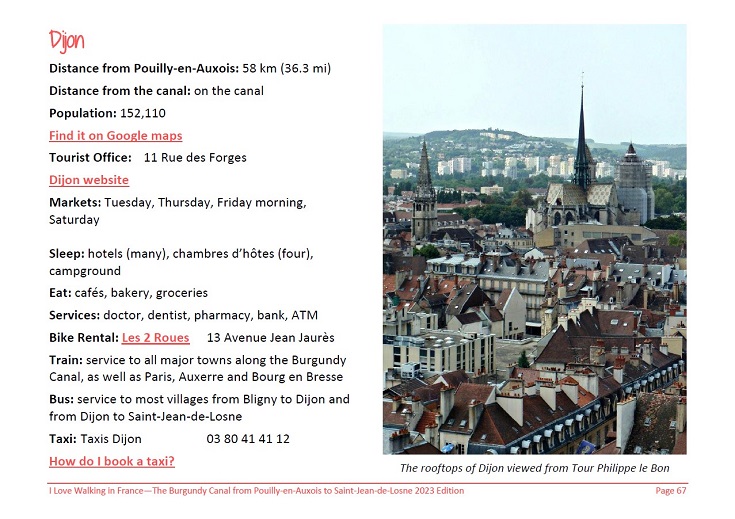
(Published July 2013, last updated June 2025)
Long ago in the fifteenth century, before France was united under one king, this corner of France was ruled by the Dukes of Burgundy, who were based here in Dijon. It wasn’t until 1477, after the death of the Duke Charles the Bold, that the area came under French rule.
Given Dijon’s rich history and abundance of museums and interesting sites, it’s definitely worth taking a day, or two, to explore the city.
There’s a lot to do, so let’s get started!
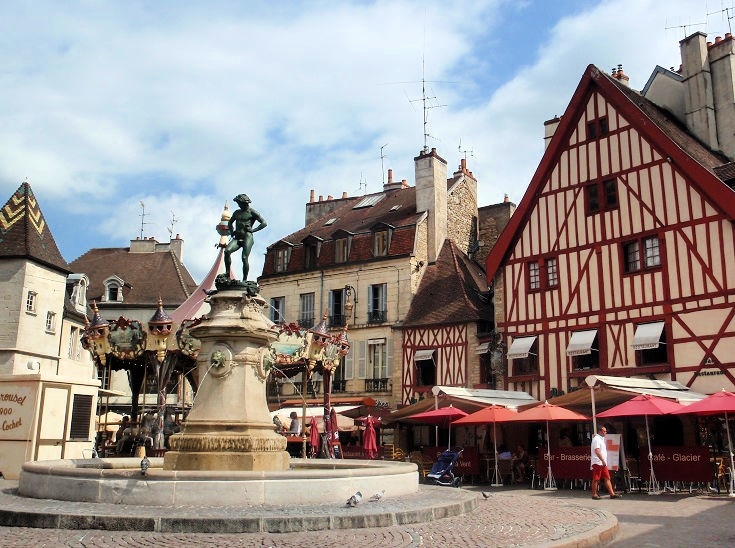
Place François Rude
Follow the Owl’s Trail
There is no better way to get your bearings and explore Dijon than by following the Owl’s Trail (available from the Tourist Office on Rue des Forges near Tour Philippe le Bon). This handy booklet includes a self-guided walk that takes in twenty-two of Dijon’s historic monuments, with suggestions for a further three loops around the city.
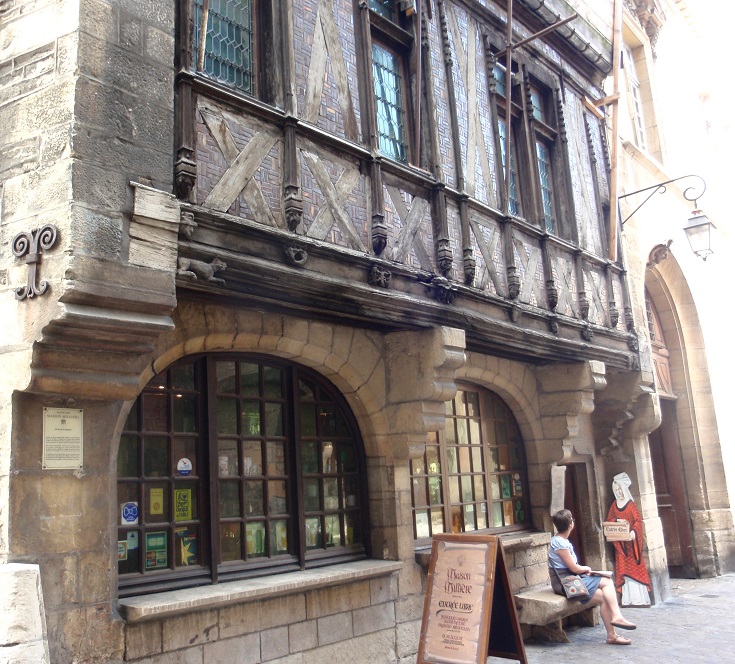
Maison Millière, stop 10 on the Owl’s Trail
Some of the highlights of this walk are—
Porte Guillaume (stop 3)—a majestic eighteenth-century arch that was once the gate into town.
Rue des Forges (stop 7)—lined with ornate thirteenth, fifteenth and sixteenth-century noble houses.
Maison Millière (stop 10)—this timbered house was built in 1483 and is typical of medieval housing throughout France, with a shop on the ground floor and housing for the shop-keeper and his family on the upper floor.
Palais de Justice (stop 18) and private mansions (stop 19)—the palace was built in the sixteenth century to house the parliament and is surrounded by stately mansions built for government officials.
The churches—take your pick from the eleventh-century Saint-Bénigne (stop 22), the twelfth-century Saint-Philibert (stop 21) or the thirteenth-century Notre-Dame (stop 8).
MUST DO—on Rue de la Chouette (stop 9), it is considered good luck to rub the owl with your left hand and make a wish.
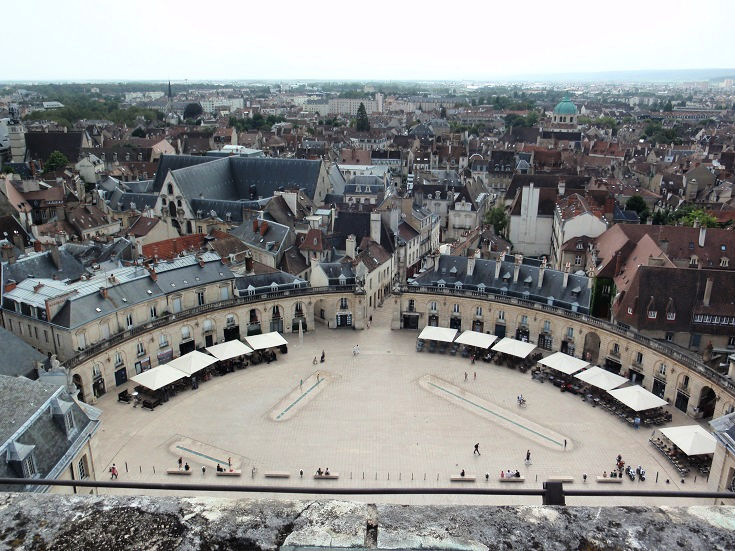
Aerial view of Place de la Libération from Tour Philippe le Bon
Explore the medieval heart of the city
The historic heart of Dijon is dominated by Place de la Libération—an enormous, semi-circular square, now lined with cafés, which was built to showcase a statue of Louis XIV. Ironically, the statue was melted down to make canons during the French Revolution.
Opposite the square, is the Palais des Ducs et des États de Bourgogne (Dukes’Palace)—built in the fourteenth century but continually restored and enlarged over the following five hundred years. Today it houses the Town Hall and the Musée des Beaux Arts, where the tombs of the Dukes can be viewed.
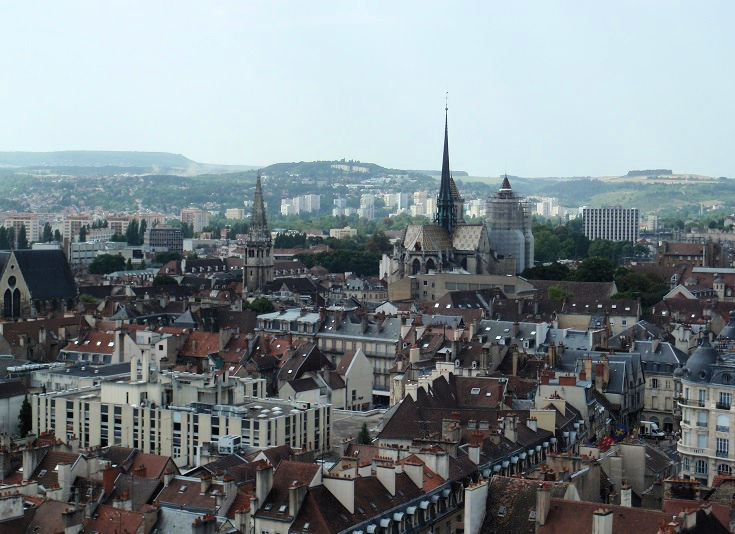
The rooftops of Dijon viewed from Tour Philippe le Bon
Climb Tour Philippe le Bon
Alongside the Palais des Ducs and accessed via the Tourist Office below, is the 48-metre high Tour Philippe le Bon.
Climb to the top for magnificent views over the rooftops of Dijon and an aerial view of the medieval centre nestled in the heart of the city.
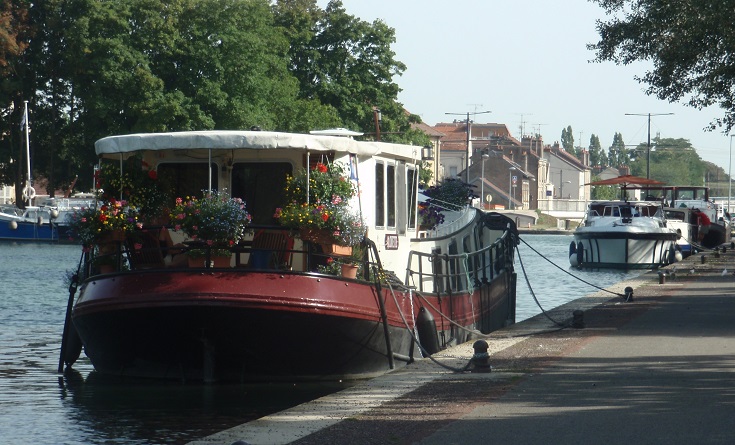
Boats moored at Port de Dijon
Take a stroll along the Burgundy Canal
If you haven’t arrived in Dijon by walking along the Burgundy Canal, now is the time to take a short detour to the outskirts of town and visit the port.
If you have a copy of the Owl’s Trail, the Moses Loop will take you in the right direction. Follow this path through the Jardin des Sciences de l’Arquebuse with its traditional, English and botanical gardens. When you reach the far side of the park, continue along the Moses Loop but instead of turning right, zigzag left, then right towards the canal.
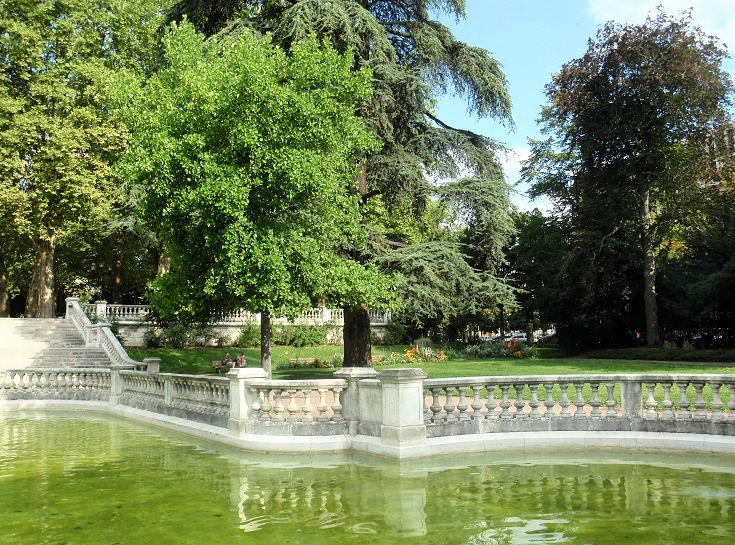
Dijon boasts several beautiful gardens where you can enjoy a leisurely stroll or a picnic lunch
When plans for the Burgundy Canal were first drawn up in the sixteenth century, the intention was to connect Dijon with Saint-Jean-de-Losne, thirty kilometres (nineteen miles) to the east. From there, boats could reach the Mediterranean Sea via the Saône and Rhône Rivers, ensuring Dijon’s role as a town of great economic importance. Subsequent plans to extend the canal west to the Yonne River were discouraged by the ruling nobility, believing that Dijon would become just another town along the way.
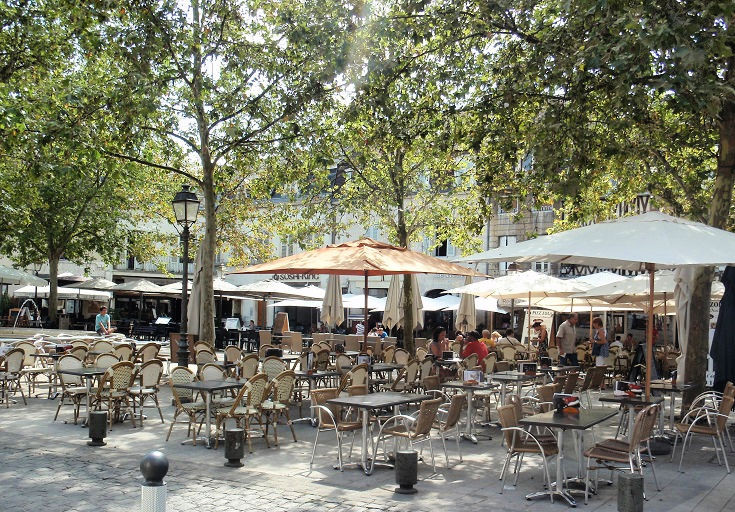
Place Emile Zola
Dijon’s economic importance may have diminished over the last few hundred years but it is certainly a most worthwhile stop on any tourist route.
No visit to Dijon is complete without a visit to one, or more, of the nearby wineries. Several options are available for guided tours to vineyards located towards Beaune and Chablis.
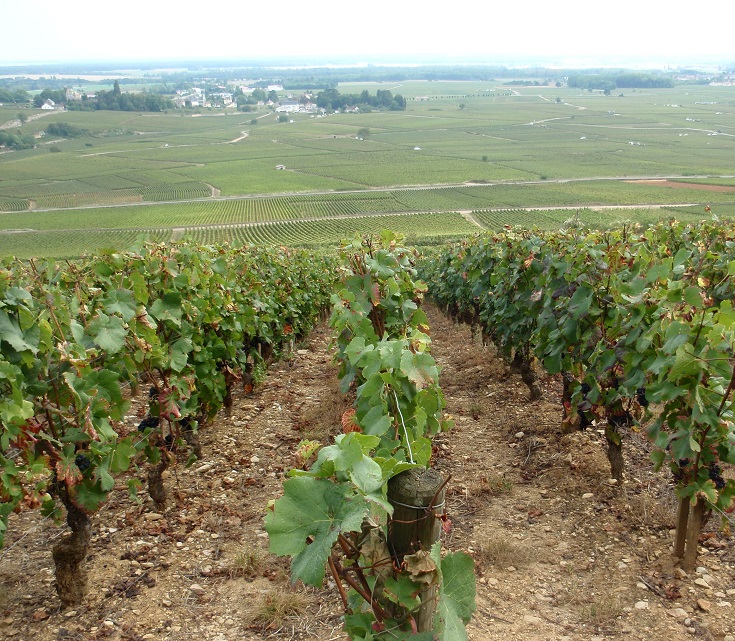
Vineyards in the Côte de Nuits, less than an hour from Dijon
And if your walk along the Burgundy Canal did not allow time for any detours, you’ll also find day tours which visit the Abbaye de Fontenay, MuséoParc Alésia or the ‘most beautiful village’ of Flavigny-sur-Ozerain.
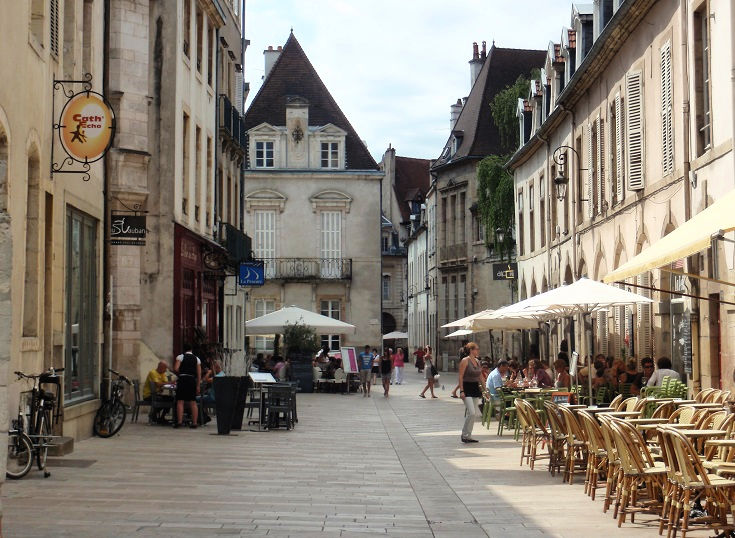
Cafés line Rue Vauban
FAST FACTS
Which long-distance walk in France visits Dijon? The Burgundy Canal (between Pouilly-en-Auxois and Saint-Jean-de-Losne)
Look inside the BURGUNDY CANAL (PDF) guidebooks
Where is Dijon, France? Find it on Google maps
Dijon is located 212 kilometres (133 miles) along the Burgundy Canal. The canal winds along the southern edge of the town and the historic centre is an easy 15-minute walk from the canal.
If you are following my suggested itinerary for this 12-day journey, you’ll arrive in Dijon after eleven days of walking and cycling from the starting point of Migennes.
This relaxed pace includes a rest day at Tonnerre and allows plenty of time to visit the nearby attractions of Abbaye de Fontenay, Château de Maulnes, Château de Tanlay and Château d’Ancy-le-Franc and the ‘most beautiful villages’ of Noyers, Flavigny-sur-Ozerain and Châteauneuf-en-Auxois.
In my suggested itinerary, I recommend cycling the last stage of the canal from Dijon to Saint-Jean-de-Losne. Bicycles can be rented from Les 2 Roues in Dijon and a connecting train service will bring you back from Saint-Jean-de-Losne the following day.
Bicycle hire is available at several Tourist Offices along the Burgundy Canal from VéliBourgogne. Bikes can be returned to any of the offices, so cycling some, or all, of the stages is very easy to arrange. Although the Dijon office remains closed in 2025, bikes can be picked up or returned at Migennes, Tonnerre, Ancy-le-Franc and Montbard.
If you prefer to set your own agenda, I share the steps I take to plan my itinerary on any long-distance walk (using the Chemin de Stevenson as a case study).
Transport options to and from Dijon
Dijon has excellent rail connections to and from Paris, but there are also several train and bus services to other towns along the Burgundy Canal including:
Train line Lyon—Dijon—Laroche—Paris connects Dijon to Laroche-Migennes, Saint-Florentin-Vergigny, Tonnerre, Nuits-sous-Ravières, Montbard, Les Laumes-Alésia and Beaune.
Train line Dijon—Laroche—Auxerre connects Dijon to Laroche-Migennes, Saint-Florentin-Vergigny, Tonnerre, Nuits-sous-Ravières, Montbard, Les Laumes-Alésia and Auxerre.
Train line Dijon—Bourg-en-Bresse connects Dijon to Ouges, Longecourt-en-Pleine, Brazey-en-Pleine and Saint-Jean-de-Losne.
Bus line 111 Dijon—Saint-Jean-de-Losne stops at Dijon, Thorey-en-Pleine, Longecourt-en-Pleine, Brazey-en-Pleine, Saint-Jean-de-Losne and Losne.
Bus line 117 Dijon—Bligny-sur-Ouche stops at Dijon, Plombières-lès-Dijon, Velars-sur-Ouche, Fleurey-sur-Ouche, Pont-de-Pany, Sainte-Marie-sur-Ouche, Gissey-sur-Ouche, Barbirey-sur-Ouche, Saint-Victor-sur-Ouche, La Bussière-sur-Ouche, Veuvey-sur-Ouche, Crugey, Pont d’Ouche and Bligny-sur-Ouche.
Bus line 118 Dijon—Saulieu stops at Dijon, Plombières-lès-Dijon, Velars-sur-Ouche, Fleurey-sur-Ouche, Pont-de-Pany, Sainte-Marie-sur-Ouche and Pouilly-en-Auxois.
Bus line 119 Dijon—Avallon stops at Dijon, Plombières-lès-Dijon, Velars-sur-Ouche, Fleurey-sur-Ouche and Pont-de-Pany.
Tourist Office in Dijon
You’ll find the Tourist Office in the historic centre of Dijon at 11 Rue des Forges. Opening hours are listed on the Tourist Office website.
Authentica Tours and Côte de Nuits cycle tour offer tours of the nearby vineyards and both can be arranged from the Tourist Office in Dijon.
Accommodation in Dijon
You’ll find dozens of hotels, ranging from 5-star luxury accommodation to clean but basic 2-star rooms, on the Destination Dijon website, and in the I Love Walking in France guidebook.
Listed below are three chambres d’hôtes (the equivalent of the English Bed and Breakfast) where you’ll find a warm, friendly welcome and personal service.
Le Petit Tertre (5 rooms, 12 people)
Marcs d’Or (5 rooms, 11 people)
La Cour Berbisey (4 rooms, 8 people)
How to book accommodation in French
Where to eat in Dijon
There is a full range of cafés, bakeries, supermarkets and speciality food stores in Dijon—as you’d expect in any large town (population 150,000).
Dijon is positively packed with outdoor cafés and no matter where you are, a good meal is close by. Some areas to consider are:
Place de la Libération—there are many cafés lining the square and offering good value meals throughout the day.
Place Emile Zola—today the square is crammed with cafés, but following the French Revolution, this was the site of public executions.
Place François Rude—a relatively new addition to the city (1904), this quiet corner near the medieval heart of town is a great spot to while away an hour or two.
Dijon is also home to five Michelin-starred restaurants. If you are looking for something special, choose from:
Origine (one star) €€€
L’Asperule (one star) €€€
Cibo (one star) €€€€
Loiseau des Ducs (one star) €€€€
Chapeau Rouge (two stars) €€€€
Prices range from very affordable to quite pricey, depending on whether you visit for lunch or dinner and choose from the degustation or à la carte menus.
Fresh food markets are held in Les Halles (Rue Odebert) every Tuesday, Thursday and Friday morning and all day on Saturday, but you’ll often find a smaller speciality market in full swing somewhere in town on other days of the week. Ask at the Tourist Office for a list of markets during your stay.
Practical tips for long-distance walking—preparation, packing and avoiding blisters
Purchase the Burgundy Canal (PDF) guidebooks (Dijon is located along the second section between Pouilly-en-Auxois and Saint-Jean-de-Losne).
Purchase both guidebooks covering Migennes to Pouilly-en-Auxois and Pouilly-en-Auxois to Saint-Jean-de-Losne
